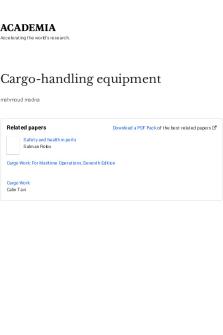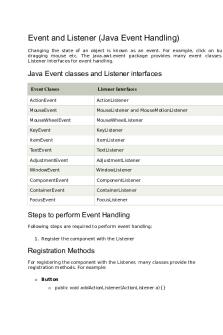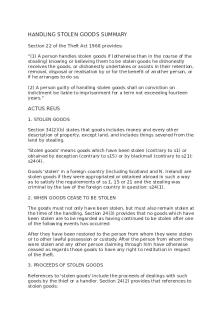Sitxfsa001 food handling PDF

| Title | Sitxfsa001 food handling |
|---|---|
| Author | Jazzy Jagga |
| Course | commercial cookery |
| Institution | Victoria University |
| Pages | 14 |
| File Size | 1 MB |
| File Type | |
| Total Downloads | 111 |
| Total Views | 284 |
Summary
Save your work with the filename <StudentID - Name - UnitName> , answer your assessment questions in this sheet below and upload the assessment once it has been completed.ASSESSMENT SUBMISSION FORMComplete this form and submit to your assessor for grading. It is recommended that you ke...
Description
Save your work with the filename , answer your assessment questions in this sheet below and upload the assessment once it has been completed.
ASSESSMENT SUBMISSION FORM Complete this form and submit to your assessor for grading . It is recommended that you keep a copy of your assessment and your assessment submission form.
Student Number Student Name Email Course Title Unit Code and Title Assessment Task No. / Title
APEX 4712 HITESH [email protected] Certificate IV in Commercial Cookery SITXFSA001 Use hygienic practices for food safety ☐ 1. Unit Knowledge Assessment (UKA) ☐ 2. Unit Skills Assessment (USA)
Trainer Name DECLARATION
√
I hold a copy of this work which can be produced if the original is lost / damaged .
√
This work is my original work and no part of it has been copied from any other student’s work or from another source except where due acknowledgement is made .
√
No part of this work has been written for me by any other person except where such collabora tion has been authorised by the instructor / teacher concerned.
√
I have not previously submitted this work for this or any other course / uni t.
√
I give permission for this work to be reproduced, communicated, compared and archived for the purpose of detecting plagiarism.
√
I give permission for a copy of my marked work to be retained by the college for review and comparison, including review by external examiners. I understand that:
√
Plagiarism is the presentation of the work, idea or creation of another person as though it is my/our own. It is a form of cheating and is a very serious academic offence that may lead to exclusion from the college. Plagiarised material can be drawn from, and presented in, wri tt en, graphic and visual form, including electronic data and oral presentations. Plagiarism occurs when the origin of the material used is not appropriately ci ted. Plagiarism includes the act of assisting or allowing another person to plagiarise or to copy my/our work .
Student Signature I declare that I have read and understood the above declaration. Student ID: apex4712 Date:15-feb-2020
Student Name:
Page 1 of 14
hitesh
Student Instructions:
All questions must be answered correctly to be completed satisfactorily.
All knowledge assessments are untimed and are conducted as open book (this means student can refer to textbooks or any resources).
Student may handwrite/use computers to answer the questions.
This assessment task may be completed in a classroom, at home, learning management system (i.e. Moodle), or independent learning environment.
You must complete all questions unassisted by the assessor or other personnel but may refer to reference material as needed.
Submission details
The Assessment Task is due on the date specified by your trainer. Any variations to this arrangement must be approved in writing by your trainer.
Fill out the Assessment Submission form to the documents you are submitting to be marked.
Please answer each question on a separate page provided and clearly indicate the question number at the top of the page.
The Trainer/Assessor may further prompt and question in order to receive answers of appropriate quality or if further clarification is required and to validate authenticity of your submitted work.
Page 2 of 14
Question 1 - Answer
1. There is legislation governing correct food handling processes in Australia and New Zealand through Food Standards Australia New Zealand (FSANZ). Who is in charge at the local government level and what powers does this authority have? Answer Local authority in charge of food safety Local Council is incharge of food safety
Executing person and their powers under the health act Environmental health officer
2. Working in the TH&E industry requires that staff follow good personal hygiene to prevent contamination in accommodation, food and beverage areas and meet industry expectations for presentation. Provide 5 examples of good personal hygiene practices. a.)
Wash your hands normally
b.)
Cover your mouth and nose while wheezing and hacking
c.)
Trim your nails
d.)
Wear antiperspirant
e.)
Shower ordinary
3. You have cut your finger during work. What do you need to do to prevent any potential contamination of food, or other items like linen in accommodation or food service areas? Why? (20 – 40 words) ANSWER Cuts or the affected area should not encounter food. Band-Aid should be applied immediately, and gloves can be used to prevent bacteria enter the wound. 4. Number the steps for the Hand washing procedure in correct order: STEP ACTION 5 Dry hands thoroughly using single use paper towels 2 Lather hands with an anti-bacterial liquid soap 3 Scrub hands thoroughly including between the fingers, the wrists, up to the elbows and under nails (use a brush to assist) 6 Apply a sanitiser 4 Rinse off hands under hot running water Page 3 of 14
1
Wet your hands under hot running water (don’t burn yourself!)
5. List 4 requirements for hand washing facilities to meet the legal requirements. • Hands ought to be washed in a predefined hand washing sink. • Soap allocators ought to be utilized rather than cleanser bars to forestall spreading of microorganisms and recontamination of hands. •
To forestall recontamination, taps ought to be fueled with a switch or foot pedal
•
Hot water ought to be utilized.
6. Provide 5 examples of instances which would require that you wash your hands.
After touching raw food
Smoking
Sneezing and coughing
Going to bathroom
Touching face and hairs
7. Food can become contaminated in 3 ways. Connect the correct cause for contamination to the relevant type of contamination: Contamination Caused through Biological contamination Arises from disease-causing microorganisms such as bacteria, moulds, yeasts, viruses or fungi. Physical contamination Food contains foreign matter such as glass, scourer shavings, wood or porcelain pieces. Chemical contamination Food being in contact with pesticides, toxic material or chemicals, which may be either naturally occurring or manmade. 8. Provide 5 examples of common sources of food contamination relevant to your area of training (for example food and beverage, cookery or accommodation services) • Soil particles •
Not washing the products of the soil before use
•
Sick individual
•
Not putting away nourishment at right spot and temperature
• Dirty utensils 9. Provide 4 examples of common causes of cross-contamination relevant to your area of training (for example food and beverage, cookery or accommodation Page 4 of 14
services) Example: handling cooked food after touching raw foods without washing hands
Using same chopping boards for different types of foods.
Touching raw meats and then preparing vegetables without washing hands between tasks.
Leaving the cooked food open for long time
Leaving seafood outside for long time
Storing vegetables and meats together 10. On your rostered day off at Futura restaurant you suffered from diarrhoea and vomiting. In the morning you feel better and you decide to go work. What are your responsibilities under the Food Act? • Inform the director •
Don't cook nourishment until the condition comes back to ordinary
• Take every single vital advance to stay away from defilement of nourishments because of the illness. 11. List 2 examples of ramifications of poor hygiene standards in an establishment: 1. Failure to conform to nourishment laws will prompt reports of infringement, fines and indictment. 2. Organization saw as in genuine infringement of sanitation guidelines might be either incidentally or for all time shut down.
12. Most food poisoning occurs through improper food safety practices. How could the following factors affect food safety? Factors affecting food safety How does this affect food safety? Not washing fruit and vegetables These are often sprayed with insecticides or are filthy Improper temperature control Bacteria grows rapidly between 5°C and 60°C Cross contamination Mixing different types of food, improper storage and handling of food can cause cross contamination Pests Regular pest control should be carried out because pests spread bacteria and can spoil food Improper cleaning Improper cleaning and sanitization can lead to multiplying of bacteria and can cause problems 13. To ensure that all staff follow correct hygiene procedures, workplaces commonly have policies in place which need to be observed. Provide 1 example of what each policy and procedure for the following aspects should contain: Aspect Policies and Procedures Personal hygiene Hand washing procedure Food safety HACCP and Food Safety Code requirements Page 5 of 14
Cleaning Training
linen and laundry cleaning procedures Organizational policies
14. Provide 5 examples of foods which are considered potentially hazardous according to Food Safety Standard 3.2.2
Raw and cooked meats.
Dairy products such as milk, custard etc.
Seafood
Processed fruits and vegetables.
Cooked rice and pasta
15. Which of the following occurrences would you need to report to a supervisor? Indicate true or false Occurrence Unsatisfactory personal hygiene standards of employees Unsatisfactory practices that lead to contamination of food, e.g. hairclips, band aids, chemicals Unsafe food handling that may lead or has led to cross-contamination Incorrect cleaning practices that are not in line with your organization’s food safety program Outdated practices that are not consistent with current requirements Staff tasting and adjusting seasoning of food before service
True/false T T
T T
T F
16. List 5 hygiene requirements you must follow when handling raw egg or egg products to prevent cross contamination: Answer •
Raw egg items ought to be kept underneath 5°c
•
Raw eggs ought to be disposed of inside 24 hours.
•
Use various holders for various clusters.
•
Wash and dry your hands when taking care of eggs.
•
Clean and clean holders after each utilization.
17. You are required to isolate eggs for nourishment groundwork (for instance sauce Mayonnaise, chocolate mousse or comparable). What apparatus do you have to use to forestall cross tainting? (10 – 30 words) Page 6 of 14
Answer Egg separator is required to isolate eggs for nourishment readiness to forestall cross tainting. 18. A client arranges a dinner and reveals to you that they experience the ill effects of gluten narrow mindedness. Rundown 5 perspectives which must be viewed as while setting up the client's dinner to forestall defilement with or through different nourishments? Answer •
Use separate utensils for arrangement.
•
Ensure flame broils and other hardware is all around cleaned.
•
Use gloves and change them between cooking errands.
•
Cooking surfaces ought to be liberated from a bread morsels, nuts and so forth.
• Do not use serving utensils for more than one time. 19. List 1 example of how each of the following health issues could cause a hygiene risk for food safety: Health Issue Example Airborne disease Parasites causing food poisoning Food-borne disease Moulds and toxins Infectious disease An infected cut or wound 20. List 8 hygienic work practices which apply for one of the following job role An apprentice chef • Clean uniform •
Trimmed and clean facial hair
•
Small and clean fingernails
•
Should consistently wash hands
•
Use hanky while hacking or sniffling
•
Use gloves while taking care of nourishment
•
never smoke in nourishment regions
• Do not eat or bite gum in nourishment taking care of regions 21. List the basic aspects of hazard analysis and critical control points (HACCP) method of controlling food safety.
To consider all the steps involved in food handling, preparation and sales.
It is vital to identify all hazards and remove all potential cause of contamination.
Page 7 of 14
Monitoring and recording temperatures of commodities, prepared food and storage and display areas time to time is needed.
22. Go to https://www.legislation.gov.au/Details/F2011C00551; Scroll down to “5 – Content of food safety programs”. In your own words, explain what a food safety program must address: A food safety program must Example: systematically identify the potential hazards that may be reasonably expected to occur in all food handling operations of the food business Monitoring of temperatures of food exposed to the Danger zone; temperatures for reheating foods or food on hold; temperature check of e.g. fresh meat on delivery from a butcher or supplier
Identify potential hazards that may occur in all food handling
operations carried out in the business.
Identify where these hazards can be controlled.
Monitor these control methods.
Provide corrective actions when a hazard is found to be not
under control.
Establish, document and verify detailed pre-requisite programs.
Be regularly reviewed for adequacy at least every 12 months.
UNIT ASSESSMENT 2 UNIT SKILLS ASSESSMENT (USA)
INSTANCE 1
Page 8 of 14
Page 9 of 14
Page 10 of 14
INSTANCE 2
Page 11 of 14
Page 12 of 14
INSTANCE 3
Page 13 of 14
Page 14 of 14...
Similar Free PDFs

Sitxfsa001 food handling
- 14 Pages

Handling solutions
- 31 Pages

MAKALAH MATERIAL HANDLING
- 8 Pages

C error handling
- 3 Pages

Cargo-handling equipment
- 22 Pages

Handling stolen goods summary
- 3 Pages

Event Handling IN JAVA
- 6 Pages

METHODS OF HANDLING DEADLOCK
- 2 Pages

Advantages of exception handling
- 2 Pages

Exception & File Handling
- 56 Pages

Workshop 08-Tran-Handling
- 5 Pages

Handling stolen goods
- 3 Pages
Popular Institutions
- Tinajero National High School - Annex
- Politeknik Caltex Riau
- Yokohama City University
- SGT University
- University of Al-Qadisiyah
- Divine Word College of Vigan
- Techniek College Rotterdam
- Universidade de Santiago
- Universiti Teknologi MARA Cawangan Johor Kampus Pasir Gudang
- Poltekkes Kemenkes Yogyakarta
- Baguio City National High School
- Colegio san marcos
- preparatoria uno
- Centro de Bachillerato Tecnológico Industrial y de Servicios No. 107
- Dalian Maritime University
- Quang Trung Secondary School
- Colegio Tecnológico en Informática
- Corporación Regional de Educación Superior
- Grupo CEDVA
- Dar Al Uloom University
- Centro de Estudios Preuniversitarios de la Universidad Nacional de Ingeniería
- 上智大学
- Aakash International School, Nuna Majara
- San Felipe Neri Catholic School
- Kang Chiao International School - New Taipei City
- Misamis Occidental National High School
- Institución Educativa Escuela Normal Juan Ladrilleros
- Kolehiyo ng Pantukan
- Batanes State College
- Instituto Continental
- Sekolah Menengah Kejuruan Kesehatan Kaltara (Tarakan)
- Colegio de La Inmaculada Concepcion - Cebu



